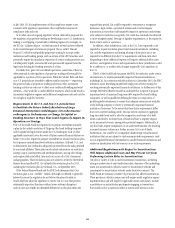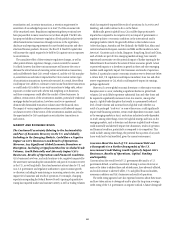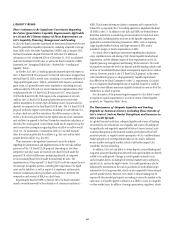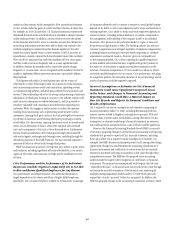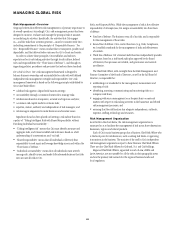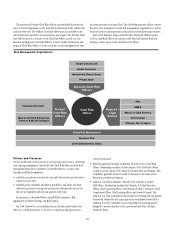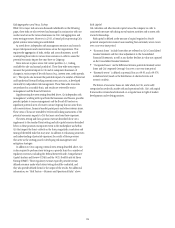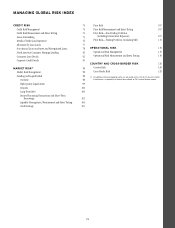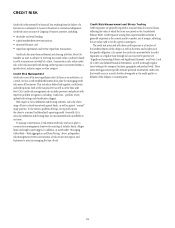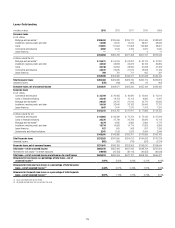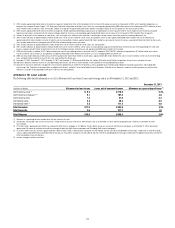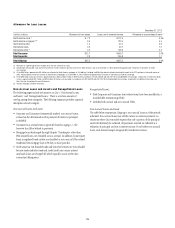Citibank 2013 Annual Report Download - page 86
Download and view the complete annual report
Please find page 86 of the 2013 Citibank annual report below. You can navigate through the pages in the report by either clicking on the pages listed below, or by using the keyword search tool below to find specific information within the annual report.68
would include in its scope many instruments currently accounted for as
financial instruments and guarantees, including some where credit rather
than insurance risk is the primary risk factor. As a result, certain financial
contracts deemed to have significant insurance risk could no longer be
recorded at fair value, and the timing of income recognition for insurance
contracts could also be changed. For additional information on these and
other proposed changes, see Note 1 to the Consolidated Financial Statements.
Changes to financial accounting or reporting standards, whether
promulgated or required by the FASB or other regulators, could present
operational challenges and could require Citi to change certain of the
assumptions or estimates it previously used in preparing its financial
statements, which could negatively impact how it records and reports its
financial condition and results of operations generally and/or with respect
to particular businesses. In addition, the FASB continues its convergence
project with the International Accounting Standards Board (IASB) pursuant
to which U.S. GAAP and International Financial Reporting Standards (IFRS)
may be converged. Any transition to IFRS could further have a material
impact on how Citi records and reports its financial results. For additional
information on the key areas for which assumptions and estimates are used
in preparing Citi’s financial statements, see “Significant Accounting Policies
and Significant Estimates” below and Note 28 to the Consolidated Financial
Statements.
It Is Uncertain Whether Any Further Changes in the
Administration of LIBOR Could Affect the Value of LIBOR-
Linked Debt Securities and Other Financial Obligations
Held or Issued by Citi.
As a result of concerns in recent years regarding the accuracy of LIBOR,
changes have been made to the administration and process for determining
LIBOR, including increasing the number of banks surveyed to set LIBOR,
streamlining the number of LIBOR currencies and maturities and generally
strengthening the oversight of the process, including by providing for U.K.
regulatory oversight of LIBOR. In early 2014, Intercontinental Exchange
(ICE) took over the administration of LIBOR from the British Banker’s
Association (BBA).
It is uncertain whether or to what extent any further changes in the
administration or method for determining LIBOR could have on the value of
any LIBOR-linked debt securities issued by Citi, or any loans, derivatives and
other financial obligations or extensions of credit for which Citi is an obligor.
It is also not certain whether or to what extent any such changes would
have an adverse impact on the value of any LIBOR-linked securities, loans,
derivatives and other financial obligations or extensions of credit held by or
due to Citi or on Citi’s overall financial condition or results of operations.
Citi May Incur Significant Losses If Its Risk Management
Processes and Strategies Are Ineffective, and Concentration
of Risk Increases the Potential for Such Losses.
Citi’s independent risk management organization is structured to facilitate
the management of the principal risks Citi assumes in conducting its
activities—credit risk, market risk and operational risk—across three
dimensions: businesses, regions and critical products. Credit risk is the
potential for financial loss resulting from the failure of a borrower or
counterparty to honor its financial or contractual obligations. Market risk
encompasses funding risk, liquidity risk and price risk. Price risk losses
arise from fluctuations in the market value of trading and non-trading
positions resulting from changes in interest rates, credit spreads, foreign
exchange rates, equity and commodity prices and in their implied volatilities.
Operational risk is the risk of loss resulting from inadequate or failed
internal processes, systems or human factors, or from external events, and
includes reputation and franchise risk associated with business practices
or market conduct in which Citi is involved. For additional information on
each of these areas of risk as well as risk management at Citi, including
management review processes and structure, see “Managing Global Risk”
below. Managing these risks is made especially challenging within a
global and complex financial institution such as Citi, particularly given
the complex and diverse financial markets and rapidly evolving market
conditions in which Citi operates.
Citi employs a broad and diversified set of risk management and
mitigation processes and strategies, including the use of various risk models,
in analyzing and monitoring these and other risk categories. However, these
models, processes and strategies are inherently limited because they involve
techniques, including the use of historical data in some circumstances, and
judgments that cannot anticipate every economic and financial outcome
in the markets in which Citi operates nor can they anticipate the specifics
and timing of such outcomes. Citi could incur significant losses if its risk
management processes, strategies or models are ineffective in properly
anticipating or managing these risks.
In addition, concentrations of risk, particularly credit and market
risk, can further increase the risk of significant losses. At December 31,
2013, Citi’s most significant concentration of credit risk was with the U.S.
government and its agencies, which primarily results from trading assets and
investments issued by the U.S. government and its agencies (for additional
information, see Note 24 to the Consolidated Financial Statements). Citi
also routinely executes a high volume of securities, trading, derivative
and foreign exchange transactions with counterparties in the financial
services sector, including banks, other financial institutions, insurance
companies, investment banks and government and central banks. To the
extent regulatory or market developments lead to an increased centralization
of trading activity through particular clearing houses, central agents or
exchanges, this could increase Citi’s concentration of risk in this sector.
Concentrations of risk can limit, and have limited, the effectiveness of Citi’s
hedging strategies and have caused Citi to incur significant losses, and they
may do so again in the future.



